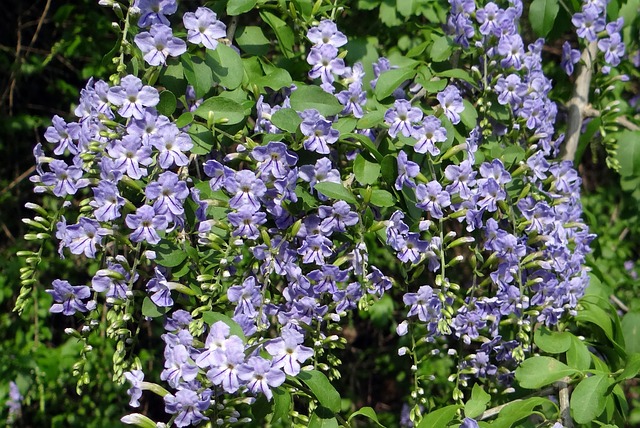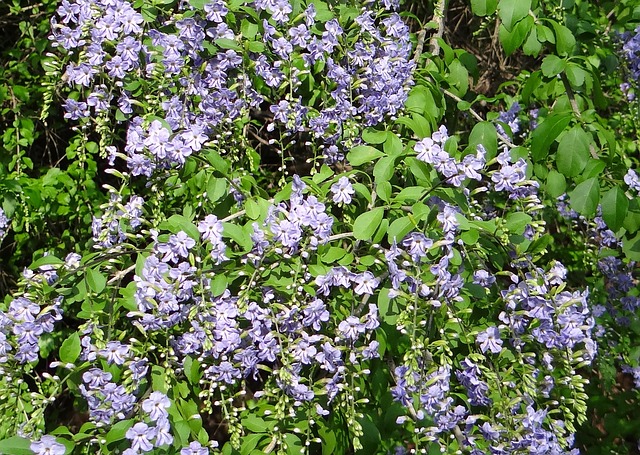Duranta

Question from Eliana:
Thanks for all your wonderful writings!
I am thinking of siting a duranta erecta in a small area next to a house with full sun, where preferred height is really only 7′ high x 5′ x 3′ wide and deep.
I realize this is asking the owners to keep the thing in major check – too much? I was also considering Senna artemisioides – that could also involve some pruning, but less, though it may not reach the min. 5′ they want to cover a bathroom window.
All the surrounding plants are low water, probably lower than the duranta. Beyond that are kangaroo paws with natives perennials in front of them. I need something tall and pretty narrow that does not have to be cut back and is not Nandina.
Should I plant it in a pot? Do you have some other suggestion?
Thank you!

Answer from Pat:
Durantaerecta is a lovely plant, one of the most beautiful we can grow. The problem is it’s too big for the space, but if I were you I might plant it anyway and just cut it back on top since it might be worth a try. A neighbor of mine has it growing on a south wall and it’s not yet 5 feet tall, been there a year facing south and looking great—about 4 feet tall now and reaching taller, so maybe not a good idea but it certainly is providing months of color. A plant such as Rhaphiolepis ‘Springtime’ is a much better choice since it is a shrub that you would never have to fight to keep down in size since it only grows 5 feet tall. Another idea more drought resistant idea is to look through the list of Ceanothus in Sunset Western Garden Book and pick one that grows to five or six feet, such as ‘Julia Phelps’, ‘Joyce Coulter’, ‘Concha,’ ‘Dark Star’, or ‘Louis Edmunds.” Among natives, have you thought of Romneya coulteri? Very drought resistant and flowers look great against a wall, but probably too invasive.
Senna artemisioides is lovely also but a lot more feathery. Another thought that comes to mind is Grevillea ‘Moonlight’. It grows six or eight feet tall and only six feet wide. Some other grevilleas might work too, but I think ceonothus might be the best idea. Great with your kangaroo paws especially if they are the gold ones.


Hi Pat,
Thank you for your ideas. The Rhaph may not get to the 5-7′ required (in this decade!) I did plant natives and Grevilleas all through the rest of the landscape, and I am including some Eriogonum in these beds. Moonlight can actually get a lot wider – if you have never been out to Blossom Valley Protea, Walter Parkola’s place, you must go take a look at his grevilleas that have been in the ground, some for decades. Inspiring! He’s in Lakeside.
Ceanothus is an interesting idea. I’ve installed it a couple other places on Mt. Helix. Not sure I can get the 5-7′ height without too much width, though (only 3′ deep bed), and Ceanothus does not like any significant pruning – not into hardwood. I’ll ask my natives mentor, good thought!
Romneya is scary invasive for a little spot like this.
If nothing else seems to work, I may just go with the Duranta, knowing they will have to keep it in check. Or plant it in a pot in the ground. Oh – and I forgot to mention that the woman Loves making cut flower arrangements.
The soil in these beds has been entirely stripped – down to subsoil. In fact, if you have any thoughts about that, I would appreciate them – it is clay and d.g., alternately, and this area has been leveled in the hardscape redesign. I’ve been thinking that for these beds I need to dig down at least 8″, then dig another 8″ to mix and replace in total a foot of soil. What do you think of that?
Thank you – it’s great to be able to bounce ideas around with someone as experienced as you,
Thanks for writing back. Sounds as if you have lots of experience yourself! Re: natives: In soil stripped bare, bulldozed or whatever, some people including Greg Ruben think this is a bonus when planting natives. (Discussed on page 37 of my organic book.) Native plants die from root rot quicker than any other problem and can get those roots out into unamended soil except pure sand. But for most plants, yes, if people can afford to replace soil it can be done, but with the caveats and in the manner described in the box on page 19.
Oh my – I only have your Southern CA Gardening book, which I have much appreciated. I just went to your website and saw your other books – quite diverse! – for the first time. I’ll be buying the organic book.
I also read your bio and saw, appreciatively, that you are also a sculptor.
I know about the not-amending ethos, but did not realize that for Greg it even extends to planting in subsoil. Now that’s a challenge for a plant! Luckily – and strangely – the drainage in that bed is good, though not on other parts of the site.
Another question, if I may bend your ear a bit more. I’ve been gardening in soil that is probably landfill, in Del Cerro, SD, surrounded by neighbors with heavy clay. It’s silty sandy awful stuff, with beyond-instant drainage. This past year, I’ve amended one small area enough to grow some veggies, but need to do more there and in another area with a languishing young Roger’s Red grape, a mulberry, and the odd squash and cuke.
What would you use on a site like this – keeping costs down – and how deep would you replace or amend? I am wondering if even going down a couple feet will really help the drainage issue – I use way too much water to keep things alive and have resorted to pots for some things.
Pat, thank you so much for making yourself available to the masses with all of our endless questions!
Appreciatively,
Eliana
Dear Eliana:
Great question and immediately the answer came to me that I just feel in my bones is the correct one: This fall, or even earlier if you want, get a truckload of aged horse manure and spread it all over your garden ahead of the rains. Do this annually in fall and you will have the best soil imaginable. (Get your tetanus shot up to date too!) Horse manure from a good farm with conscientious owners who pick up daily from corals is the best stuff. Cow manure has too many salts and also hormones.
Really nothing else is needed to fix up soil and if you have good drainage, then Yippee! Decomposed granite is a great source of mineral richness. You will have the most marvelous garden you can imagine. Don’t worry about the smell; it will soon dissipate. Your ground will be teaming with earthworms and have everything in it that plants need to grow. Grassy weeds? Yes maybe. That’s a possibility, but worth it for the payoff. Either hoe them under or if you are not planning to plant with seeds use an organic preemergent such as corn gluten meal which is also a fertilizer. (Don’t use this if you plan to plant from seeds.) I used to spread the horse manure for some years and the weeds were the kind that were easy to hoe under in wet weather. They just rot and add more goodness to the ground.
If the manure is not aged you can even spread it on the ground as is and let it age on top of the ground and all the goodness will wash into the soil where you want it instead of under the manure pile. One of the Ohio farm advisors has been saying that for many years, but out here the farm advisors are all (or mostly all) against manure because of salts. I’ve never had that problem of plants dying from salts in manure, in my fast-draining sandy soil.
Pat
Very appealing – I think I will do it, though in order to have room for the manure, I will dig and replace some of the nasty landfill. By the way, I don’t have d.g. – that is the client who has it.
Thanks for your thoughts!
I had 4 sweet memory plants at my other house in Fountain Hills, AZ until the freeze killed it a few years ago. Since then I could not find the vine that I grew on trellises. I had looked everywhere.
I have since moved a town away and did find one at a local nursery. I was so excited and though I only have room for one plant, I planted it hoping to attract hummingbirds, as I did at my other location. The one plant will not produce any flowers or fruit. Do you need two to pollinate?
Thank you!
I agree that Duranta repens is a handsome plant. The fruit is poisonous, but I trust you know this. The cultivar you have, “Sweet Memories’ is thornless. It needs regular water and balanced fertilizer. It does not need a pollinator but sometimes will not bloom the first year after planting. However, the main reason plants might not bloom is lack of sun. Duranta can take partial shade in hot, sunny interior locations but as a general rule it requires full sun. Sometimes flowering plants that have too much nitrogen and not enough phosphorus and potassium will grow instead of flowering. I do not know if this is the problem with your plant, but offer it as an additional idea. Make sure it has enough sun and try feeding with high-bloom formula.
Hello Pat,
I’m a northern California gardener who wonders if it is possible to grow the memory vine from seed?? I have some great plants in pots that I brought from my old house by taking cuttings. Now they have orange seeds on the ends. How/when should I start them?
Thanks for being there for us!
Terria Lee
First, many thanks for your kind thank you. I do this blog as a public service and it pleases me that so many people appreciate my help.
Regarding your question, you used a common name: ie: “memory vine”. I have never heard that common name and I have no idea what
that plant might be. Please can you try to find out the botanical name of that plant? Then write me again. Meanwhile go ahead and try planting the seeds. If you live in a frost-free climate, freeze some of the seeds overnight before planting outdoors, and if the plant comes from a cold-winter climate, that will make them germinate.